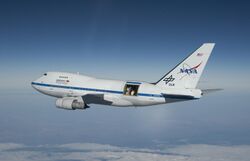Astronomy:Airborne observatory

An airborne observatory is an airplane, airship, or balloon with an astronomical telescope. By carrying the telescope to a sufficiently high altitude, the telescope can avoid cloud cover, pollution, and carry out observations in the infrared spectrum, above water vapor in the atmosphere which absorbs infrared radiation. Some drawbacks to this approach are the instability of the lifting platform, the weight restrictions on the instrument, the need to safely recover the gear afterward, and the cost compared to a comparable ground-based observatory.[not verified in body]
History
Balloon-borne telescopes have been used for observation from the stratosphere since the Stratoscope I was launched in 1957.[1] A number of different instruments have since been carried aloft by balloons for observation in the infrared, microwave, X-ray and gamma ray bands. The BOOMERanG experiment, flown between 1997–2003,[2] and the MAXIMA, which made flights in 1998 and 1999,[3] were used to map the Cosmic Microwave Background Radiation.
In 1973, the French Concorde prototype, c/n 001, was modified with roof-top portholes for a solar eclipse observation mission of 30 June 1973, at the end of the French testing programme. Observational instruments were installed on board, and the aircraft flew across Africa for 74 minutes. The airplane is now at the Le Bourget Air and Space Museum on permanent displace in eclipse livery, with the portholes displayed.[4] The Kuiper Airborne Observatory, first flown in 1974, consisted of a 36 in (91 cm) aperture Cassegrain reflector carried aloft on a C-141A jet transport to perform infrared observations. In terms of aperture, the largest aircraft-borne instrument to date is a 2.7 m (110 in) reflector telescope carried by a modified Boeing 747 for the Stratospheric Observatory for Infrared Astronomy (SOFIA) project. This instrument was put into use for astronomical observation in 2010.[citation needed] On 29 June 2015, the dwarf planet Pluto passed between a distant star and the Earth producing a shadow on the Earth near New Zealand that allowed SOFIA to study the atmosphere of Pluto.[5]
List of specially-built airborne observatories
Airplane-based observatories
| Observatory | Aircraft | Tail# | In-service | Out-of-service | Notes | ||
|---|---|---|---|---|---|---|---|
| NASA Galileo Airborne Observatory | Convair 990 | N711NA | 1965 | 1973 | Destroyed in a mid-air collision | [6][7] | |
| NASA Kuiper Airborne Observatory (KAO) | 
|
Lockheed C-141A Starlifter | N714NA | 1974 | 1995 | Replaced Galileo, replaced by SOFIA | |
| NASA-DLR Stratospheric Observatory for Infrared Astronomy (SOFIA) | 
|
Boeing 747 | N747NA | 2010 | in-service | Replaced KAO |
See also
- Observatory
- Space telescope
- Telescope
- Timeline of telescopes, observatories, and observing technology
References
- ↑ Kidd, Stephen (September 17, 1964). "Astronomical ballooning: the Stratoscope program". New Scientist 23 (409): 702–704. https://books.google.com/books?id=3qpBF3BjFE4C&pg=PA702. Retrieved 2011-02-28.
- ↑ Masi, S. (2002). "The BOOMERanG experiment and the curvature of the universe". Progress in Particle and Nuclear Physics 48 (1): 243–261. doi:10.1016/S0146-6410(02)00131-X. Bibcode: 2002PrPNP..48..243M.
- ↑ Rabii, B. (July 2006). "MAXIMA: A balloon-borne cosmic microwave background anisotropy experiment". Review of Scientific Instruments 77 (7). doi:10.1063/1.2219723. Bibcode: 2006RScI...77g1101R.
- ↑ Chris Hatherill (9 March 2016). "When Astronomers Chased a Total Eclipse in a Concorde". Motherboard (Vice). https://motherboard.vice.com/en_us/article/the-concorde-and-the-longest-solar-eclipse.
- ↑ Veronico, Nicholas A.; Squires, Kate K. (29 June 2015). "SOFIA in the Right Place at the Right Time for Pluto Observations". NASA. http://www.nasa.gov/feature/sofia-in-the-right-place-at-the-right-time-for-pluto-observations. Retrieved 1 July 2015.
- ↑ Thijs Kouwenhoven. "Flying Telescopes?". Astronomers Without Borders. https://astronomerswithoutborders.org/321-awb-blog/dark/gam-2014-blog/2176-flying-telescopes.html.
- ↑ Arthur M. Marx (23 November 2016). "Airborne Observatories: Astronomy Takes Flight". SpaceRip. http://www.spacerip.com/airborne-observatories-astronomy-takes-flight/.
